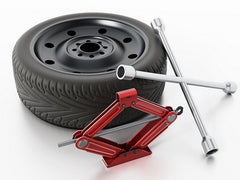WHAT TO DO IF YOU GET A FLAT TYRE ON YOUR FLOAT?
Every equestrians worst nightmare! You are on your way to a competition you have spent the last couple of weeks tirelessly preparing for and your float gets a flat tyre along the way!
This short blog will take you through a step-by-step guide on what to do if you get a flat tyre on your float. The below procedure shouldn’t take any longer than 15 to 30 minutes.
STEP ONE: PULLOVER SAFELY
As soon as you realise something isn't quite right whilst towing, safely slow your vehicle and float, indicating to pull over to the side of the road when it is safe to do so. Ideally, you want to pull over on a straight, level road with a wide shoulder, never pull over on a narrow shoulder as this puts you at risk of being hit. Once pulled over safely, clear of traffic, turn on your hazard lights.
Ensure your vehicle is parked with the parking brake on. The safest option when pulled over on the side of a road is to leave the horses in the float where they are safe and restrained. Leave the float hooked up to your vehicle as it will be most stable when secured on a towball.

STEP TWO: ASSESS THE SITUATION
Assess the situation and extent of the damage. Check your horses in the float, ensuring they are safe and settled. Keep an eye on your horses from outside of the float with our Equine Eye float camera and app.

STEP THREE: PREPARE YOUR EQUIPMENT
Always carry these essential items in case of a flat tyre:
- Tyre wrench
- Spare inflated float tyre
- Trailer jack
- Reflective hazards triangle
- Bricks or blocks of wood
- WD40

STEP FOUR: CHOCK THE WHEELS OF THE FLOAT
Using bricks or blocks of wood, wedge them in front or behind the tyres to prevent the float from moving with the horses inside.

STEP FIVE: LOOSEN THE TYRE NUTS
Using your wrench, turn the nuts counterclockwise, if they are tight use the WD40 to aid with loosening them. Once loose, do not completely remove them as yet.

STEP SIX: POSITION THE TRAILER JACK
Position the trailer jack in a safe and stable area beneath the float frame, nearest the flat tyre. Place a small cut of wood beneath the jack to prevent it from becoming off balance.

STEP SEVEN: RAISE THE FLOAT
Slowly jack up the float whilst keeping an eye on your horses from outside your float with our Equine Eye float camera and app. Raise the float until the flat tire is approximately 15 cm off the ground. Be sure to never place any part of your body beneath the float when raised on the jack.
STEP EIGHT: REMOVE THE FLAT TYRE
Once the flat tire is 15 cm above the ground, completely remove the nuts. Grip the tire and gently pull it towards you until it is free from the bolts and hub. Secure the flat tyre in place of the spare tyre.
STEP NINE: INSTALL THE NEW TYRE
Gripping the new tyre, lift it and line up the holes in the rim with the bolts on the hub. Push gently until the bolts are exposed through the rim. Put the nuts back on the bolts and tighten them by hand.

STEP TEN: LOWER THE FLOAT
Slowly lower your float with the jack until the spare tire is completely on the ground, remove the jack. Turning clockwise, tighten the nuts with the wrench as tight as you can.
STEP ELEVEN: DRIVE SAFELY
Now that you have successfully changed your float tyre you can be on your way. Drive carefully keeping an eye on your horses throughout the journey with our Equine Eye float camera and app.

